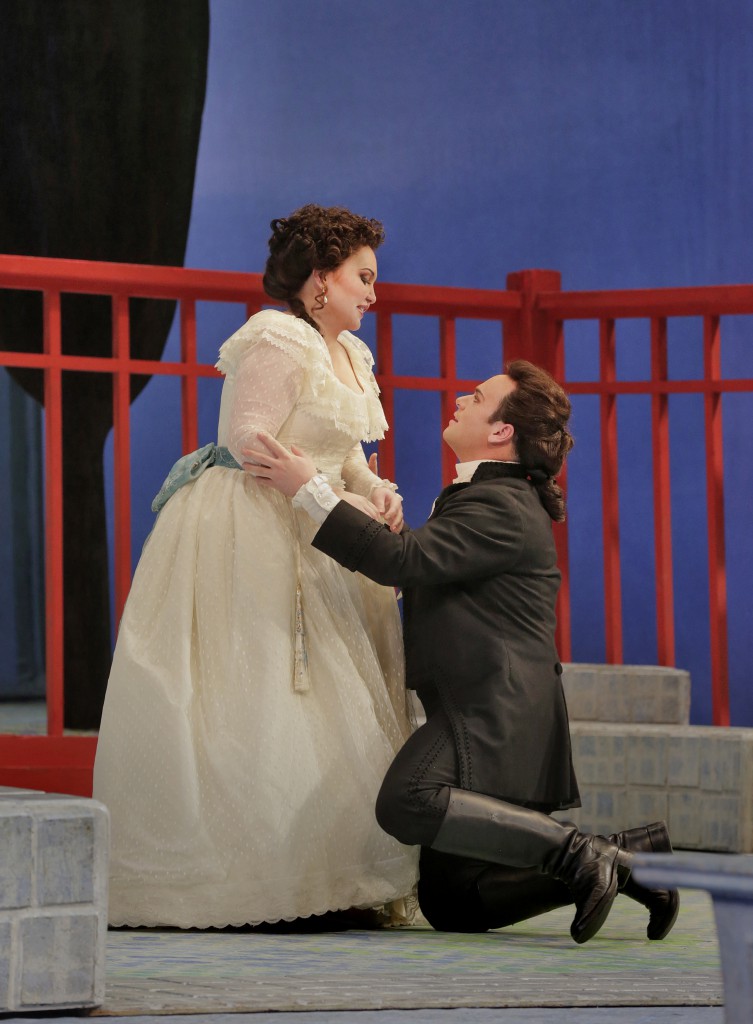Brilliant singing triumphs over flaws in Met’s “Abduction”

Albina Shagimuratova and Paul Appleby in Mozart’s “Die Entführung aus dem Serail.” Photo by Ken Howard
As his special chair rose from the pit at the Metropolitan Opera House Friday night before the start of Die Entführung aus dem Serail, James Levine received even more than his usual ovation. For the first opening night of the season following his retirement announcement, Levine’s welcome was not just applause but hoots and hollers before the start of every act.
Levine deserved them for his long, ambitious and wildly successful tenure as music director at the Met. One especially appreciated the opportunity to enjoy Serail, which Levine essentially premiered (Abduction from the Seraglio had five performances in 1946 and then none at all until Levine brought it to the house in 1979). And while objectively Friday night’s opener was ambiguously shaped and in some ways technically shaky, the final experience was fulfilling.
Tempos were inconsistent all night, dipping and rising like an old reel-to-reel tape. The pace was relaxed in general, at times too much so. In Singspiel form, the spoken dialogue between musical set pieces means there are none of Mozart’s brilliant recitatives or large-scale scene making. The start of many arias and duets felt like the setting up of musical numbers.
In the end this was all forgotten. Serail has some of Mozart’s most glorious arias, “numbers” that accomplish the unique, Mozartian feat of expressing a character’s nature and complexity through music that is breathtaking and technically dazzling. The apocryphal story that Emperor Joseph II complained of “too many notes” comes out of this opera.
With singing like there was Friday night, there were just as many notes as there should be. The comical story of abduction, love, and rescue is a template upon which Mozart glorifies the voice. Shining most brilliantly are the two coloratura soprano parts, with Albina Shagimuratova in the leading role of Konstanze and Kathleen Kim as Blondchen.
Both hit their high notes spectacularly well, and there was a nice separation in vocal quality; Shagimuratova darkly shaded and Kim pearly.
Their singing was not just beautiful to the ear—every note cleanly articulated, fully supported, and without strain—but wonderfully characterful. Kim’s “Durch Zärtlichkeit” was not just sweet but brimming with theatrical, naïve, self-confidence (Steve Pickover’s stage direction made excellent use of the astounding difference in size between the tiny Kim and the towering bass Hans-Peter König as Osmin.)
Shagimuratova was the magnetic center of the performance. Her arias grabbed the attention with their high runs and turns, then held it with a mesmerizing expression of character and feeling. This was especially true in “Marten aller Arten,” which received one of the finest performances this listener has ever heard.
Tenor Paul Appleby sang the role of the somewhat heroic Belmonte, paired with the Pedrillo of tenor Brenton Ryan, in his company debut. Appleby is ideal in this part; beyond his considerable technique, his singing embodies the lyrical, sincere, youthful yearning that is a staple of Mozart. He has a fine ear for harmony and made the most out of the music’s appoggiaturas.
Pedrillo is Belmont’s (and Osmin’s) comic foil, and Ryan took to the part eagerly. He sounded effortful in his first act duet with Appleby, but through the final two acts sang smoothly.
König is a natural as Osmin, his rich, resonant voice and imposing, but light-footed, size seem perfect in the part. He can hold drama and comedy together in the same note, opening it with an edge and then warming it with his tone and vibrato.
Shagimuratova, Appleby, and König all sang with their own fluctuations in tempo, ones that were often different than the orchestra’s. But they kept their phrases internally consistent and directed towards the musical and expressive completion of a lyrical line.
The non-singing role in the cast is that of Pasha Selim, and Matthias von Stegmann carried an easy, humane authority in the role. The production is John Dexter’s original from 1979, and while some of the costume stylings have a hint of a Pucci hangover, it is still fresh. The simple, attractive, Hockney-esque sets and mix of pastels and earth colors should remain attractive for generations to come.
In the end, the orchestral playing was quite fine. Despite the tempo fluctuations, the orchestra held together and drove the music with verve. Every phrase had that wonderful Mozart quality of poise, sweetness, and intellectual and emotional depth. The overture moved easily and well between vivacity and delicacy.
The musical and dramatic pleasure of the evening was a testament to Levine, who had set the wheels in motion so well that the music unspools almost by itself.
Die Entführung aus dem Serail continues through May 7. metopera.org


